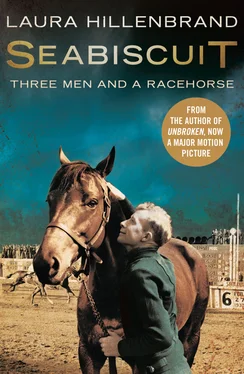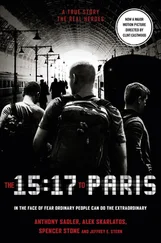Once riders were down on the course, tracks had virtually no protocol for coping with their injuries. Riders were lucky if someone rounded up a car to get them to a hospital, and since virtually none of them had any money or insurance, they were likely to be turned away from any hospital to which they were taken. Track officials appeared to feel little obligation to them. In 1927 best friends Tommy Luther and Earl “Sandy” Grahamwere slated to ride a pair of stablemates in the same race at Winnipeg’s Polo Park. Luther was assigned to a lumbering, uncoordinated colt named Vesper Lad, while Graham was up on Irish Princess II. At the last minute the trainer reversed the assignments. While Luther was hustling Irish Princess to the lead, he heard a gasp from the crowd. He finished the race, then pivoted in the saddle to see what had happened. He saw Graham lying motionless on the track. Vesper Lad had rammed into the rail, dropping Graham to the track, where he had been trampled by the field. His ribs and back were shattered.
Track officials carried Graham up to the jockeys’ room and dumped him on a saddle table, where he lay moaning and incoherent. It had been decided that Graham could wait until after the races, when it was most convenient for someone to drop him by the hospital. Luther and the other jockeys were not permitted to leave the jockeys’ room to take him in themselves. Had they done so, they would have lost their jobs and housing. Though Luther passed the hat to raise cabfare to send him on alone, the jockeys didn’t have enough money among them. Luther spent the afternoon sitting with Graham, offering him water and pleading in vain with officials to get the boy to the hospital. Finally, after the races were over, Graham was taken to the hospital, where Luther sat by his bed. The race season soon ended, and Luther was forced to leave his friend’s side to accompany his trainer to another track.
A few days later Graham died. He was only sixteen. His death was little noticed; jockey fatalities were so common that they rarely earned more than a slim paragraph in the press. The only person left in town to mourn for Graham was a woman the riders called Mother Harrison, operator of a Turkish bath that Graham and Luther had frequented. She buried the boy but couldn’t afford a headstone. Luther mailed what little money he could spare to Mother Harrison to buy a grave marker. With the leftover money, she bought a small bouquet of flowers and laid it on the boy’s grave. She drew a picture of the grave and mailed it to Luther. Seventy years later Luther still has the drawing.
The racetrack casualty list was full of stories of the cruel, the bizarre, and the miraculous. In 1938, leading Agua Caliente jockey Charlie Rosengarten gave up the mount on the favorite, Toro Mak, to a struggling rider named Jimmy Sullivan, who needed the money to feed his wife and newborn baby. Rosengarten watched in horror as Toro Mak, sailing toward a sure victory, inexplicably crossed his forelegs and fell, crushing Sullivan to death. After a spill that knocked him unconscious, facedown in a puddle, Eddie Arcaro would have become the first jockey in history to drown on the job had a photographer not rushed out from the stands and turned his head to allow him to breathe. Steve Donoghue, who rode in Europe and the United States in the interwar years, was once on a horse that clipped heels and fell, spilling him onto the track in front of a mob of onrushing horses. He was an instant from being trampled to death when an elderly woman suddenly materialized out of nowhere, grabbed hold of him, and dragged him under the rail. She left him in the safety of the infield, and vanished. Donoghue never saw her again.
But nothing tops the strange fate of Ralph Neves, a hard-headed, hard-riding teenaged jockey known as “the Portuguese Pepperpot.” One afternoon in May of 1936, driving a filly around the far turn of California’s Bay Meadows Racecourse, Neves was on the lead and looking like a cinch to win. But without warning, the horse stumbled and crashed. Flipping to the track, Neves was trampled by trailing horses. The filly rose, uninjured-Neves had evidently broken her fall-but the jockey lay motionless. Two physicians in the crowd sprinted out to him, joining the track doctor.
Neves was not breathing and his heart had stopped. They declared him dead on the track. The race caller made the somber annonncement and asked the crowd to stand in prayer. As the sickened spectators bent their heads and reporters rushed to get word to their editors, Neves’s body was carried into the track infirmary and parked on a table. According to one report, his boot was pulled off and his toe was tagged. Between ten and twenty minutes later, with Neves’s body already growing cold, the track physician decided to take a shot at the moon and injected Neves’s heart with adrenaline.
Neves woke up.
He asked the physician if he had won the fifth race. The stunned doctor told him the fifth hadn’t been run yet. Neves promptly stood up and announced that he had to get back to riding. The physician refused to let him go, and rushed the uncooperative jockey to a hospital in San Mateo, where attendants tried to hold him for observation. Neves, still fixated on riding the rest of the card, bolted from his gurney and made a run for it. Hospital staffers chased him outside, snagged him and pulled him back in, but Neves soon broke loose again, made it out the door, leaped into a cab, and rode back to Bay Meadows. Once at the track, he jumped out and began rushing toward the jockeys’ room.
As the shirtless, blood-splattered erstwhile corpse sprinted past the grandstand, astonished fans started running after him. By the time Neves hit the wire, most of the crowd was chasing him. Evidently hopped up on the adrenaline injection, Neves shook loose from the mob, dashed past the clubhouse, and burst into the jockeys’ room. He scared the bejesus out of everyone.
When the jockeys recovered from the shock, they took Neves, kicking and screaming, down to the first-aid room. He insisted that he was going to ride his one remaining mount. The incredulous stewards refused and insisted that he return to the hospital. Neves refused. He came back the next day loaded for bear. While San Franciscans were reading his obituary in several papers, the decidedly undead Neves rode like a man possessed, finishing second or third on all five of his mounts. Reports of his death were fifty-nine years premature.
A sidelined jockey was a forgotten jockey. Because of this cold reality, most jockeys would ride through virtually anything, and they shrugged off the grisliest injuries. “I got my leg broken once and my skull fractured once,” said former rider Wad Studley, “but never nothin’ bad.” Johnny Longden once won a major race while riding with broken bones in his back and foot. When a colt named Daddy Longlegs bolted for the closed paddock gate, sailed over it upside down, and landed on top of him, Steve Donoghue simply strapped his broken wrist bones together with cloth and rode one-handed. On another occasion, his boot caught in the stirrup as he fell off, causing him to be dragged by his foot down the track. His head bumped along beside his filly’s thrashing legs until his leg snapped and his foot came free. Not wanting to give up his mount in an upcoming race, Donoghue drove to the stables, had himself carried to his horse, and rode every day with a bulky plaster cast on his leg. Most incredibly, he rode for a full year with serious internal injuries incurred when another horse spiked him into the ground. Though he knew he had been critically injured, he refused treatment and grew weaker and weaker until someone finally took him to a doctor. The moment he entered the office, he fainted into his physician’s arms. He was rushed to emergency surgery and barely survived. The motivation for riding through such pain soon became all too clear. While still hospitalized, he was summarily fired by his contract trainer.
Читать дальше











